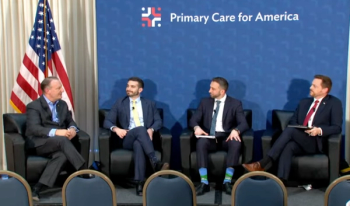
- Medical Economics November 2021
- Volume 98
- Issue 11
How to hire - and keep - the right employees for your practice
Physicians in office practice know that a professional, motivated staff is key to a practice’s success. But finding, training and retaining employees can be a significant challenge for practices.
Introduction:
Physicians in office practice know that a professional, motivated staff is key to a practice’s success. But finding, training and retaining employees can be a significant challenge for practices. For example, in 2018 the median annual turnover rate for front office staff in primary care practices was 20%, according to a Medical Group Management Association survey.
The stress brought on by the COVID-19 pandemic has only worsened the problem, as evidenced by health care workers at all levels reporting increasing rates of burnout and depression. According to the Bureau of Labor Statistics, the quit rate among health care and social assistance employees increased from 2.1% to 2.7% between August 2020 and August 2021, while overall a record-breaking 4.3 million Americans quit their jobs in August of this year.
Fortunately, there are strategies medical practices can use to create workplace cultures that minimize staff burnout and turnover, and where employees feel empowered — and encouraged — to do their best work. But creating such an environment requires planning and the willingness to take a fresh look at all aspects of practice operations.
Learning objectives:
- Best practices in staffing, with lessons learned from COVID-19.
- Tips to improve staff retention and scheduling.
- How to enhance office efficiency, reduce patient wait times and create a better experience for all.
Meet the panelist:
Owen Dahl, LFACHE, CHBC, LSSMBB principal of Owen Dahl Consulting The Woodlands, Texas
How to hire — and keep — the right employees for your practice
Finding and retaining good employees is difficult for many independent medical practices even in the best of times, and doing so during the COVID-19 pandemic has made these tasks even harder. But according to longtime practice consultant Owen Dahl, LFACHE, CHBC, with good planning and the right strategies in place, practices of any size can overcome their staffing challenges.
Building a good staff starts with a hiring process that brings in the right people. Once candidates have been screened for their technical skills, it’s important to determine if they are a good fit for the practice’s culture. To that end, Dahl advises asking candidates plenty of open-ended questions that allow candidates to talk about themselves. He also suggests including current employees in the interviewing process.
“One of the most important things is chemistry you establish with your applicants and finding out how well they relate to your staff,” he says. “It’s much easier to train and change a skill set than it is to change a personality.”
After hiring, the next step is an effective onboarding process. This should include someone in practice leadership introducing the new employee to their colleagues, explaining the organization’s policies and procedures, reviewing benefits, familiarizing them with the technology they’ll be using, and assigning them a mentor. “You want to make that person feel like they’re part of the organization right from the start,” Dahl explains.
In terms of payroll, Dahl emphasizes the importance of looking beyond individual salaries and focusing instead on the employee’s value to the practice. He cites the example of a medical assistant. “You may see that person just as an expense, but he could behandling your EHR, your patient communications and other things that save you enough time that you can see one more patient per day. Seeing an extra patient per day for a99213 visit at Medicare rates generates roughly $20,000 per year, not including labs, imaging and ancillaries.
“I always like to think of an employee as a revenue generator rather than as an expense,” he adds.But hiring good people is of limited value if they lack motivation or don’t stay for long. Employee turnover is a major challenge throughout the economy, Dahl says, citing surveys in which nearly half of employed people say they are seeking other jobs or new careers.
So what can a practice do to build loyalty and make employees want to stay? Money isn’t always the answer, Dahl says, although salaries should be high enough that it isn’t a source of stress. Equally important are things like flexible scheduling and allowing emergency leave to care for child care or sick relatives — a particularly important benefit during a pandemic.
When developing benefit packages, it’s also important to focus on the differing needs of employees. “Think about the age mix of your staff, for example. For younger people, what kind of benefit package is going to enhance their retention versus someone who may have been with the practice for 20 years?”
Even when employees leave, Dahl says, a well-functioning organization should conduct exit interviews and try to learn from them. For example, multiple people leaving because of having to work too much overtime may indicate that something is amiss with employee staffing. “We have to ask, do we have the right number of employees with the right skill sets needed to move forward?” he says.
With the impact of COVID-19 still being felt, Dahl says, burnout remains a significant problem, citing Gallup polling data in which 67% of employees report feeling burned out “often” or “sometimes.”
Given those circumstances, practice owners and managers need to watch for signs of it among employees — and themselves — Dahl warns.Symptoms include declining productivity, changes in sleep habits, increased drug or alcohol use and lack of engagement with colleagues and/or patients.
“The engagement aspect is really critical when we think about mental health,” Dahl says. “What kind of messages are we sending to patients and fellow employees relative to how engaged we are about being in the office?”
A good technique both for spotting burnout and improving engagement, according to Dahl, is what he calls “MBWA”: management by walking around. “It’s important to talk to your staff and listen not just to their words but the tone of voice and body language,” he says. “You can only do that by walking around.”
Solutions and takeaways:
- Review hiring and interviewing procedures to ensure you’re getting candidates who are a good fit for the organization.
- Develop an onboarding process to make new employees feel welcome and smooth their entry into their position.
- Conduct exit interviews with departing employees and use information they provide to identify and address organizational problems.
- Tailor benefits to employee needs.
- Use “management by walking around” to engage with staff members and learn about their needs and concerns.
Articles in this issue
about 4 years ago
What it's like to be a concierge medicine doctorabout 4 years ago
Beating a malpractice suit starts with these 3 stepsabout 4 years ago
How to be a telehealth physicianabout 4 years ago
How to digitally engage with patientsabout 4 years ago
How to negotiate for a higher salary — and winabout 4 years ago
Is an MBA right for you?about 4 years ago
What physicians need to know about exchange-traded fundsabout 4 years ago
Beware the trend of for-profit medicineabout 4 years ago
Federal Reserve: No rate hike…yetabout 4 years ago
Inflation explained: 5 ways it impacts your wallet and the economyNewsletter
Stay informed and empowered with Medical Economics enewsletter, delivering expert insights, financial strategies, practice management tips and technology trends — tailored for today’s physicians.


















